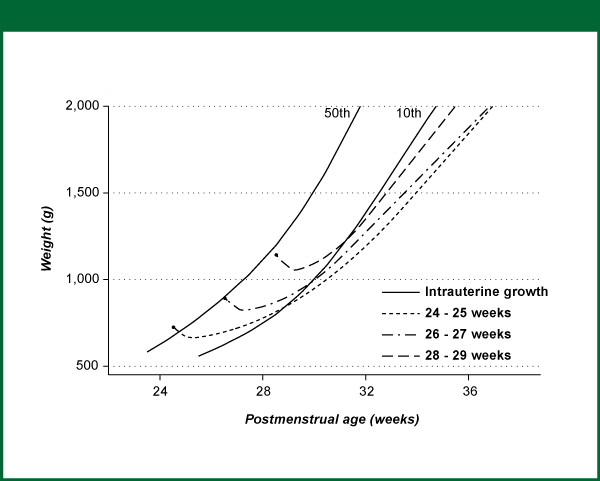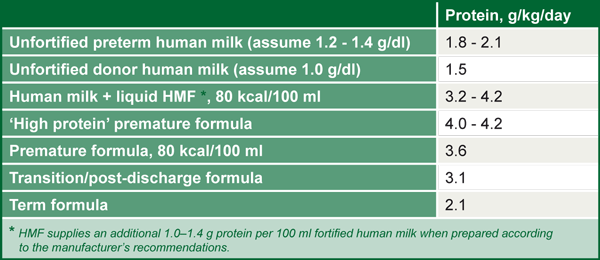Lesson 4: Specific Preterm Infant Nutritional Management
4.3 Nutritional management in growth faltering
Although prevention of growth faltering, through adequate nutritional intake in the NICU, is the best approach to avoid extrauterine growth retardation (EUGR), EUGR still is highly prevalent among preterm infants (Figure 5).
Figure 5: Average body weight vs. PMA in weeks for infants 24-29 weeks
(GA plotted with smoothed 10th and 50th percentile reference IU growth curves. The infants are stratified by GA weeks 24-25, 26-27 and 28-29
Source: Ehrenkranz 2014, reprinted with permission of S. Karger AG, Switzerland
Optimizing early protein intake, either parenterally or enterally is the main goal in the management and prevention of growth failure. A delivery of early intravenous of 2.0-3.0 g/kg/day of amino acids to ELBW, soon after birth, is recommended. A 3.75 - 4.0 g/kg/day of protein intake is the recommendation for preterm infants born between 24 to 25 weeks GA (Poindexter 2014).
The use of 'stock' or 'starter' amino acid solutions is a valuable strategy in the NICU for delivery of adequate amounts of protein to the preterm infant. Such solutions are normally pre-prepared locally in the facility pharmacy and then can be stored in the NICU at room temperature for up to a week. A common solution contains 5% neonatal amino acid solution with 7.5% dextrose in a 250ml bag. An amino acid delivery of 3 g/kg/day can be reached when the solution is run at 60 ml/kg/day. Extra fluids, dextrose and electrolytes can be co-infused with the 'stock' solution when necessary (Poindexter 2014).
Transition from parenteral to enteral feeding is a period which health care providers should take special attention to avoid suboptimal nutrition. A recommended strategy is to prescribe full parenteral nutrition during the advancements of enteral feedings, but run the parenteral nutrition in a lower speed (accounting for the volume given enterally). With this approach, it is possible to increase the parenteral nutrition if feeding intolerance develops (Poindexter 2014), therefore avoiding inadequate nutrient delivery.
Once the preterm infant is on full enteral feeding, optimizing the enteral protein intake is essential. Table 10 compares the protein intake available in the different enteral feeding means. Only fortified HM and 'high protein' preterm infant formula is able to deliver a protein supply of 4 g/kg/day in a volume of 150 ml/kg/day.
Table 10: Comparison of protein intake for enteral nutrition at 150 ml/kg/day
Source: Poindexter 2014, reprinted with permission of S.Karger AG, Switzerland

